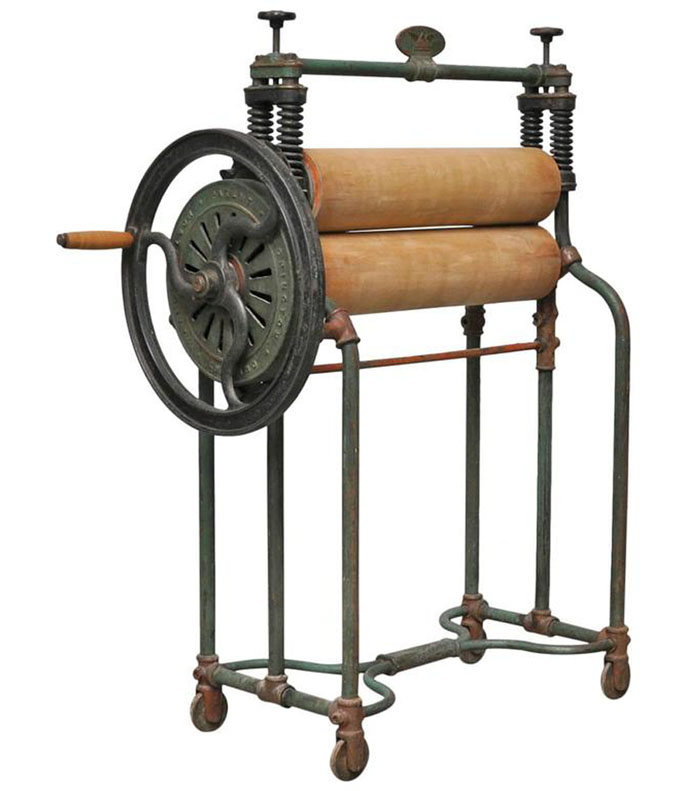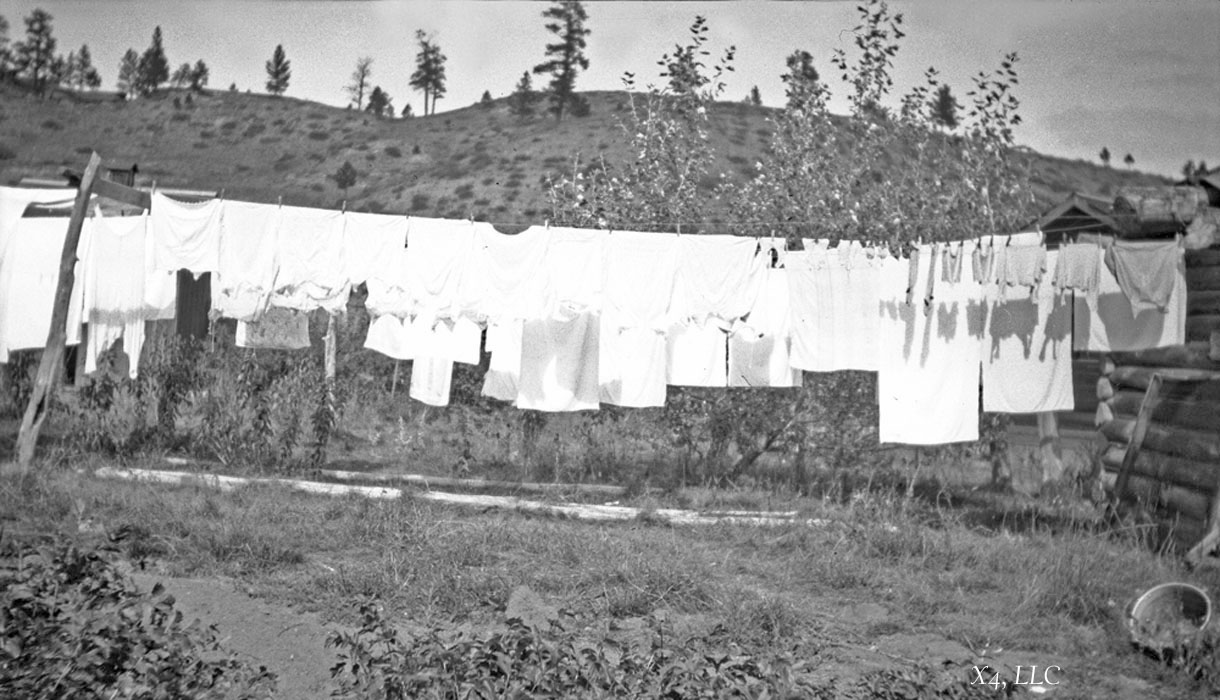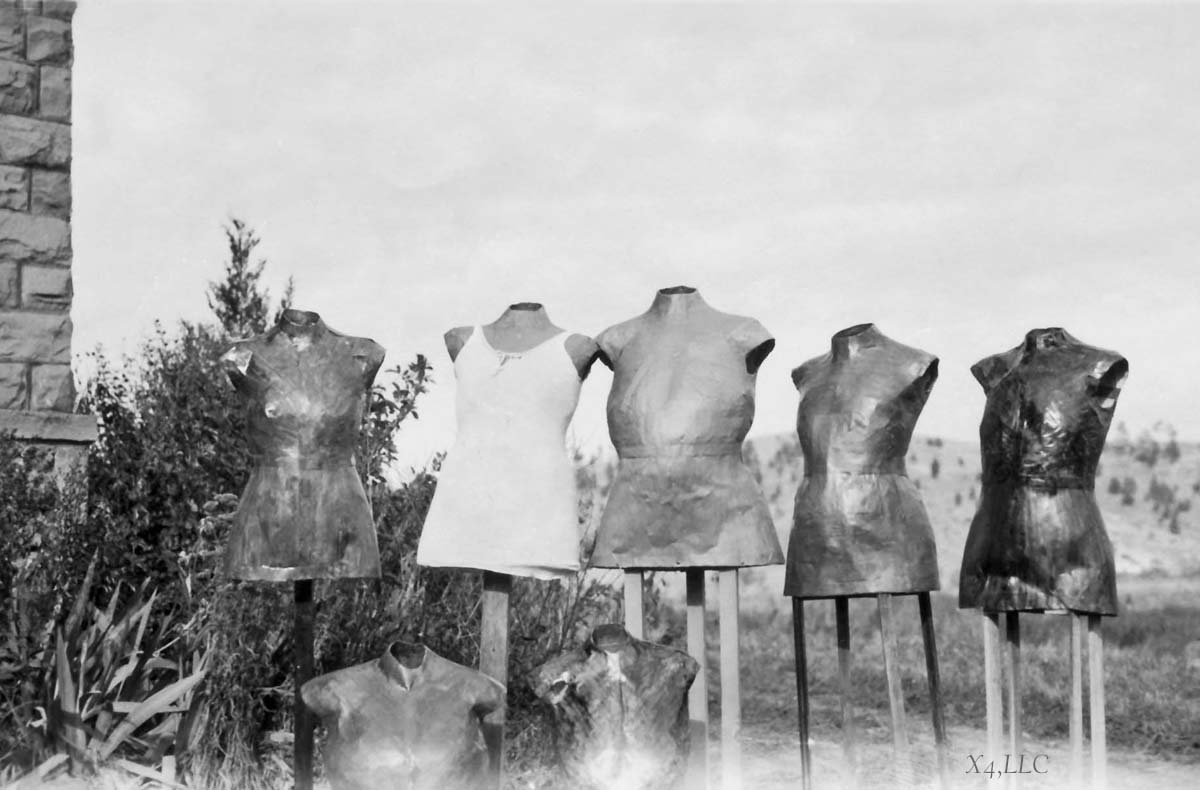Women’s work is never done.
Apr 14, 2022 by Tempe Javitz
Women's work is never done. How did Jessamine find time for photography?
Why is that statement still true today? With all the modern conveniences
including a husband who vacuums, why am I still washing (not ironing)
clothes and endless piles of dishes, dusting every room, and ignoring
the dirty windows? This is supposed to be the age of machines, I want
a robot!
My grandmother Jessamine had no choice. It literally was washing all
day Monday, ironing all day Tuesday and sometimes part of Wednesday.
She also sewed most of the clothes for her family during the 1920s. This
is a woman with seven children, a cook (thank heavens), the local teacher,
and several hired hands to keep house for.
Mangles: Do you know what a mangle is? Picture this:

Photo provided by prior owner via www.1stdibs.com. They share great images.
A mangle wrings the water out of your wash. Jessamine also had one that
was designed to iron large articles like sheets using steam with the rollers.
Instead of just pressing her sheets, she figured out how to iron her clothes!
Friday, March 1, 1929: “Ironed on the mangle today. Six weeks
of ironing in two hours flat.” (She obviously left the old-style iron still
sitting on her stove.)
With all this work Jessamine was like a Sufi whirling dervish.
Thursday, June 24, 1920: “Washed today for the first time in three weeks.”
(Can you imagine?)
Friday, June 25, 1920: “Finished the washing today with the power washer.”
(This made me laugh as I envisioned todays ‘power washer’ attached to a hose
and Jessamine hosing down the clothes like a mad woman.)
People were always stopping by to visit. A friend of Jessamine’s, Vivian,
came out from Sheridan. “I washed so long that Vivian accused me of bringing
washing from town to do.”
Considering all the time Jessa spent on household chores there is only one
photo of the laundry- her last child (Brad’s) wash on the line. Among thousands
of photos, there is not one of the mangle, the clothes washer, the sewing machine,
or even the kitchen in which she spent many hours. It certainly was a relief to
get out of the house, and take her camera with her. She notes one day in 1920,
“I’d sure hate to be tied to a washtub every single Monday that came around!”

Brad’s baby clothes on the wash line.
Wednesday, January 28, 1920: “Cut out clothing for the girls. The girls’
new blue dresses are simply lovely. I am going to embroider a rose on each
of them.” (I think Jessamine found sewing more fun than washing the clothes.
See the amusing take on dress making forms below. She could poke fun at
these everyday chores.)

Jessamine’s dress making forms lined up for a portrait.
Reminiscent of modern art!
Lice! As if cleaning house wasn’t enough.
Saturday, March 20, 1920: “Today we washed all the blankets from the children’s beds
and changed all the bedding and put mange cure on all the children’s heads. We
washed Torrey and Eileen’s hair as they had lice in their hair. We found some of
August’s castoff clothing covered with lice. (August was a hired man.) We gave
the beds and Bill’s room a regular spring cleaning. I used creosote in the water
and around the mattresses, then cleaned the closet thoroughly. Oh dear, we were
so tired that I only washed 12 pairs of blankets. Thank goodness, it was lovely
spring weather and the blankets dried so soft and nice.”
Moral of the story: Ladies and gentlemen count your blessings. The first upright
Hoover vacuum cleaner didn’t appear until 1926. Vacuum cleaners were considered a
luxury item until after WWII, when middle class women could finally afford one.
Many of our clothes nowadays are permanent press. Pop them in the dryer and hang
them in the closet. Our clothes are washed in a lovely clothes washer, while we do
other things. Been watching any Soaps? Then we move the load to the dryer.
Lice? Well, my boys got them at school once, and I practically shaved their heads.
The Lice treatment from the drugstore did the trick. I’m grateful for our modern
conveniences!
Cowboy jargon--Chute: A tight passage between fences or rails in which horses or
cattle may be held with a locking gate at either end. It also refers to the
passage way through which cows or horses are driven up a loading dock onto trucks
or railroad cars. For more information about Jessamine Spear Johnson’s extraordinary
life go to tempejavitz.com and click on “the book” button. My book about her
photography will be published later this year by the South Dakota Historical
Society Press.
.jpg)
Why is that statement still true today? With all the modern conveniences
including a husband who vacuums, why am I still washing (not ironing)
clothes and endless piles of dishes, dusting every room, and ignoring
the dirty windows? This is supposed to be the age of machines, I want
a robot!
My grandmother Jessamine had no choice. It literally was washing all
day Monday, ironing all day Tuesday and sometimes part of Wednesday.
She also sewed most of the clothes for her family during the 1920s. This
is a woman with seven children, a cook (thank heavens), the local teacher,
and several hired hands to keep house for.
Mangles: Do you know what a mangle is? Picture this:

Photo provided by prior owner via www.1stdibs.com. They share great images.
A mangle wrings the water out of your wash. Jessamine also had one that
was designed to iron large articles like sheets using steam with the rollers.
Instead of just pressing her sheets, she figured out how to iron her clothes!
Friday, March 1, 1929: “Ironed on the mangle today. Six weeks
of ironing in two hours flat.” (She obviously left the old-style iron still
sitting on her stove.)
With all this work Jessamine was like a Sufi whirling dervish.
Thursday, June 24, 1920: “Washed today for the first time in three weeks.”
(Can you imagine?)
Friday, June 25, 1920: “Finished the washing today with the power washer.”
(This made me laugh as I envisioned todays ‘power washer’ attached to a hose
and Jessamine hosing down the clothes like a mad woman.)
People were always stopping by to visit. A friend of Jessamine’s, Vivian,
came out from Sheridan. “I washed so long that Vivian accused me of bringing
washing from town to do.”
Considering all the time Jessa spent on household chores there is only one
photo of the laundry- her last child (Brad’s) wash on the line. Among thousands
of photos, there is not one of the mangle, the clothes washer, the sewing machine,
or even the kitchen in which she spent many hours. It certainly was a relief to
get out of the house, and take her camera with her. She notes one day in 1920,
“I’d sure hate to be tied to a washtub every single Monday that came around!”

Brad’s baby clothes on the wash line.
Wednesday, January 28, 1920: “Cut out clothing for the girls. The girls’
new blue dresses are simply lovely. I am going to embroider a rose on each
of them.” (I think Jessamine found sewing more fun than washing the clothes.
See the amusing take on dress making forms below. She could poke fun at
these everyday chores.)

Jessamine’s dress making forms lined up for a portrait.
Reminiscent of modern art!
Lice! As if cleaning house wasn’t enough.
Saturday, March 20, 1920: “Today we washed all the blankets from the children’s beds
and changed all the bedding and put mange cure on all the children’s heads. We
washed Torrey and Eileen’s hair as they had lice in their hair. We found some of
August’s castoff clothing covered with lice. (August was a hired man.) We gave
the beds and Bill’s room a regular spring cleaning. I used creosote in the water
and around the mattresses, then cleaned the closet thoroughly. Oh dear, we were
so tired that I only washed 12 pairs of blankets. Thank goodness, it was lovely
spring weather and the blankets dried so soft and nice.”
Moral of the story: Ladies and gentlemen count your blessings. The first upright
Hoover vacuum cleaner didn’t appear until 1926. Vacuum cleaners were considered a
luxury item until after WWII, when middle class women could finally afford one.
Many of our clothes nowadays are permanent press. Pop them in the dryer and hang
them in the closet. Our clothes are washed in a lovely clothes washer, while we do
other things. Been watching any Soaps? Then we move the load to the dryer.
Lice? Well, my boys got them at school once, and I practically shaved their heads.
The Lice treatment from the drugstore did the trick. I’m grateful for our modern
conveniences!
Cowboy jargon--Chute: A tight passage between fences or rails in which horses or
cattle may be held with a locking gate at either end. It also refers to the
passage way through which cows or horses are driven up a loading dock onto trucks
or railroad cars. For more information about Jessamine Spear Johnson’s extraordinary
life go to tempejavitz.com and click on “the book” button. My book about her
photography will be published later this year by the South Dakota Historical
Society Press.
.jpg)
8-30-1929, Cattle pushed up the chute to the RR cars at
Spear Siding, Montana on the Little Big Horn River.
